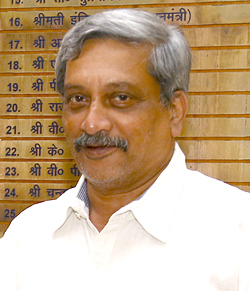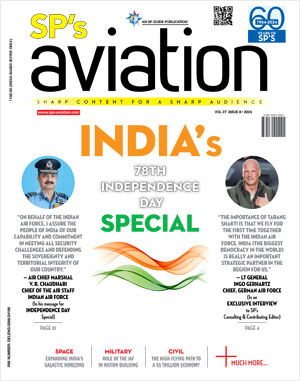INDIAN ARMED FORCES CHIEFS ON OUR RELENTLESS AND FOCUSED PUBLISHING EFFORTS

SP Guide Publications puts forth a well compiled articulation of issues, pursuits and accomplishments of the Indian Army, over the years

"Over the past 60 years, the growth of SP Guide Publications has mirrored the rising stature of Indian Navy. Its well-researched and informative magazines on Defence and Aerospace sector have served to shape an educated opinion of our military personnel, policy makers and the public alike. I wish SP's Publication team continued success, fair winds and following seas in all future endeavour!"

Since, its inception in 1964, SP Guide Publications has consistently demonstrated commitment to high-quality journalism in the aerospace and defence sectors, earning a well-deserved reputation as Asia's largest media house in this domain. I wish SP Guide Publications continued success in its pursuit of excellence.
DPP 2016 uploaded – what is new
 |
By Lt. General P.C. Katoch (Retd) Former Director General of Information Systems, Indian Army |

On 8 June 2016, MoD uploaded on its website the DPP 2016 Chapters I to VI including Appendices and Annexures. The covering letter reads "A separate Chapter on Strategic Partners and Partnership will be notified separately. However, no policy on blacklisting has been included in the DPP, which presumably will be announced later. It may also be recalled that when the Defence Acquisition Council (DAC) cleared the clause of increased offset baseline from Rs. 300 crore to Rs. 2,000 crore besides focusing on reducing delays in procurements, the Defence Minister had stressed the new DPP will ensure modernization of defence forces remains unaffected due to procedural intricacies. The media had also highlighted the proposed DPP focuses on: reducing delays in procurements by eliminating repetitive procedures; new clauses allowing procurements in through single vendor with proper justification; government readiness to pay 10% extra for products better than others; new category of Indigenously Designed Developed and Manufactured (IDDM) as the most preferred category for procurements, and; the three services to each have dedicated 'Project Management Units' headed by two-star general rank officers driving all 'Make' projects relating to respective service. 'Make' procedure was proposed to be divided in three sub-categories: Make I involving 90% funding of development cost by government; government refunding 100% development cost in Make II in case request for proposal (RFP) not issued within two years of developing prototype; and Make III reserved for small and medium scale enterprises (MSMEs) for projects worth less than Rs. 3 crore.
Subsequently, when DPP 2016 was released on March 28 by Defence Minister Manohar Parrikar while inaugurating DefExpo 2016 in Goa minus its appendices and annexures. It was then brought out in these columns that the plusses in the DPP 2016 included introduction of the new procurement category 'Buy IDDM'; buying indigenously designed, developed and manufactured products with minimum 40% indigenous content, and if not designed and developed indigenously with minimum 60% indigenous content. 'Buy (IDDM) should ostensibly replace 'Buy (Indian)' since latter also now requires 40% indigenous content instead of erstwhile 30%. How the acquisition process will be shortened will need to be observed through the application of the new DPP on ground because the stages of acquisition cycle remain practically same. Other plusses included: Services Qualitative Requirements (SQRs) split into two categories as essential and desirable (Essential Parameters A and Essential Parameters B) with contracts signed based on A and vendor permitted to develop B after award of contract; Services Equipment Policy Committees (SEPCs) responsible for finalizing SQRs permitted to seek expert assistance; RFPs will include Enhanced Performance Parameters (enhanced capabilities over and above the essential parameters) with vendors meeting additional parameters given weightage up 10% for determining lowest bid; threshold for offsets raised from INR 300 crore to 2,000 crore; procedure defined to deal with change in name of vendor during procurement cycle for any reason including merger, acquisitions etc; provision for adoption of a model wherein the foreign vendor can select an Indian Production Agency (IPA) from the private sector of its choice when MoD has not nominated a DPSU for the joint venture (JV) albeit if several Indian companies tie up with the foreign vendor, it will not be treated as 'single vendor'; funding of projects by the MoD increased from 80% to 90%, with balance 10% reimbursed (if RFP not issued within two years of successful development of prototype) and development agencies given mobilization advance of 20% of estimated cost of development; projects with estimated development cost of 10 crore under Make category funded by Mod and 3 core for Make category self-funded by developers will be earmarked for MSMEs, opened to others only if MSMEs don't evince interest; Annual Acquisition Plan (AAP) for Make projects to be notified by MoD; sharing future military needs with industry through a Technology Perspective and Capability Roadmap (TPCR), covering 15-years acquisition plans. Appendix 'D' to Chapter II and its annexures has laid out detailed offset guidelines but whether wholly-owned subsidiaries of foreign companies qualify as Indian Offset Partners (IOPs) is not addressed. This perhaps is considering the low technology base in the country implying they 'may' qualify depending on the importance of the product and criticality of its need.
The DPP categorically lays down procurement in descending order of priority through categories of: Buy (Indian - IDDM); Buy (Indian); Buy and Make (Indian); Buy and Make, and; Buy (Global). It qualifies that 'Make' category of procurement would be pursued in isolation, in sequence or in tandem with any of the five categories with a separate heading under Services Capital Acquisition Plan (SCAP) and Annual Acquisition Plan (AAP). With relation to Field Evaluation Trials (FET), the DPP says, "After the acceptance of TEC Report, all selected vendors would be asked to provide their equipment for trials in India, except when trials are to be conducted at vendor premises". It is a moot question whether after the AugustaWestland helicopter experience; we want to leave the option of FET at vendor premises outside India. The DPP lays down that an 'Integrity Pact' would need to be signed between government department and the bidders (both Indian and foreign vendors) for all procurement schemes over 20 Crores. Why this has been applicable to 'all' schemes and whether this leaves a loophole for schemes up to 20 crores is a moot question. In terms of Technology Acquisition by DRDO, multipliers have been permitted as follows: Multiplier 2.0 applicable when technology offered for use by Indian Military only without restriction on numbers that can be produced; Multiplier 2.5 applicable when technology offered for use only in Indian Market (both military and civil) without restriction on the numbers that can be produced, and; Multiplier of 3.0 applicable when technology offered without restriction and with full and unfettered rights, including right to export. Such provision applicable only to DRDO is unlikely to be appreciated by indigenous private industry. Defence agents have been authorized to foreign entities under the new DPP. The acquisition timeframe up to signing of the main contract has been listed from 86 to 114 weeks. It may be better than what was earlier in vogue notwithstanding the inevitable slippages going by past history, but certainly a separate faster process could have been defined for communications and information systems considering the rapid rate of technological advance. As for slippages there are ample provisions in DPP 2016, but will they be applied to the governmental defence-industrial complex which is directly under the MoD? Acquisition under Fast Track Procedure (FTP) has been categorized as: procurement of equipment already inducted into Service, and; procurement of new equipment. The vital question here is will MoD apply this to existing critical voids of the military and how about organizing additional budgetary support for it? The previous FTP policy was of 2001 vintage but while this may have been revised, we have the live example of Defence Minister Parrikar announcing 'emergent' procurement of 50,000 bullet proof jackets in 2014 which have still not been provisioned despite army's deficiency having gone up beyond 3,50,000. It is ironical that the issue of strategic partners has been left out despite the long time taken to define the new DPP and especially when the Dhirendra Singh Committee had spelt out guidelines for choosing strategic partners. It goes without saying that choosing strategic partners will have political connotations and will invariably change with different ruling parties at the Centre. So why delay the policy decision which is eagerly awaited by the private sector with much apprehension? Hopefully, the yet to be spelt out blacklisting policy will also ensure that such action does not adversely impact defence preparedness, recent example being the faux passé created with regard to our strategic submarine projects by cancelling the Black Shark torpedoes because of blacklisting Finmeccanica. Finally, as they say, the proof of the pudding lies in its eating. No matter how good or bad DPP 2016 may be, it is the implementation in letter and spirit that is going to matter.





